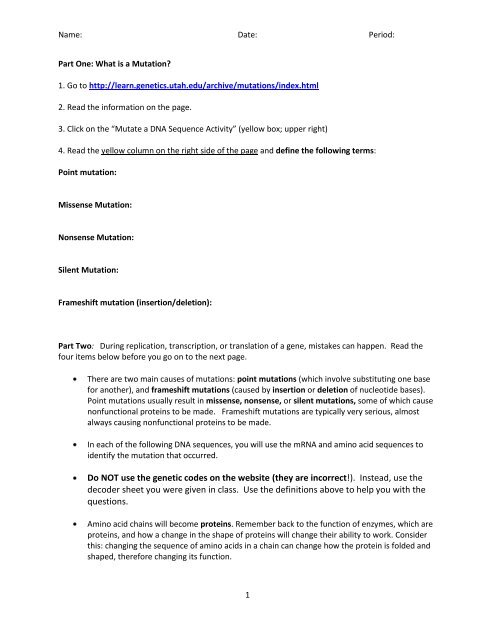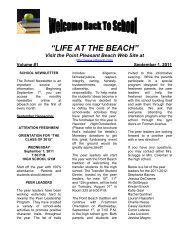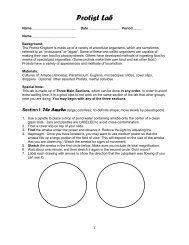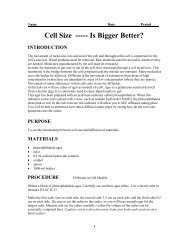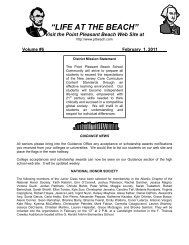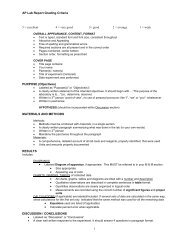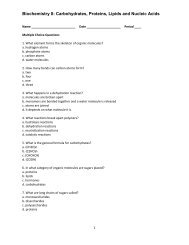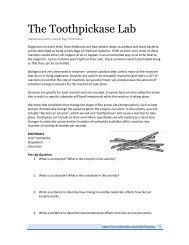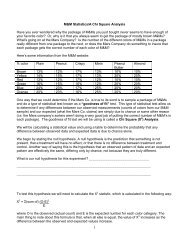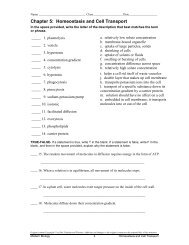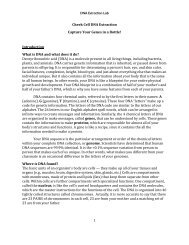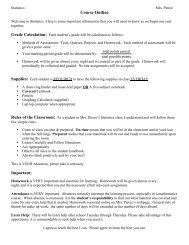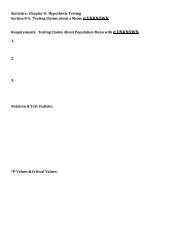Mutations Webquest - Point Pleasant Beach
Mutations Webquest - Point Pleasant Beach
Mutations Webquest - Point Pleasant Beach
Create successful ePaper yourself
Turn your PDF publications into a flip-book with our unique Google optimized e-Paper software.
Name: Date: Period:<br />
Part One: What is a Mutation?<br />
1. Go to http://learn.genetics.utah.edu/archive/mutations/index.html<br />
2. Read the information on the page.<br />
3. Click on the “Mutate a DNA Sequence Activity” (yellow box; upper right)<br />
4. Read the yellow column on the right side of the page and define the following terms:<br />
<strong>Point</strong> mutation:<br />
Missense Mutation:<br />
Nonsense Mutation:<br />
Silent Mutation:<br />
Frameshift mutation (insertion/deletion):<br />
Part Two: During replication, transcription, or translation of a gene, mistakes can happen. Read the<br />
four items below before you go on to the next page.<br />
There are two main causes of mutations: point mutations (which involve substituting one base<br />
for another), and frameshift mutations (caused by insertion or deletion of nucleotide bases).<br />
<strong>Point</strong> mutations usually result in missense, nonsense, or silent mutations, some of which cause<br />
nonfunctional proteins to be made. Frameshift mutations are typically very serious, almost<br />
always causing nonfunctional proteins to be made.<br />
In each of the following DNA sequences, you will use the mRNA and amino acid sequences to<br />
identify the mutation that occurred.<br />
Do NOT use the genetic codes on the website (they are incorrect!). Instead, use the<br />
decoder sheet you were given in class. Use the definitions above to help you with the<br />
questions.<br />
Amino acid chains will become proteins. Remember back to the function of enzymes, which are<br />
proteins, and how a change in the shape of proteins will change their ability to work. Consider<br />
this: changing the sequence of amino acids in a chain can change how the protein is folded and<br />
shaped, therefore changing its function.<br />
1
Name: Date: Period:<br />
Original DNA Sequence:<br />
T A C A C C T T G G C G A C G A C T<br />
mRNA Sequence:<br />
Amino Acid Sequence:<br />
Mutated DNA Sequence #1:<br />
T A C A T C T T G G C G A C G A C T<br />
Corresponding mRNA sequence?<br />
Corresponding amino acid sequence?<br />
Circle the mutation. How many amino acids are different from the original protein? ________<br />
What kind of mutation is this? (circle ALL that apply) <strong>Point</strong> mutation Frame shift<br />
Silent Insertion Deletion Nonsense Missense<br />
cle the change)<br />
Mutated DNA Sequence #2:<br />
T A C G A C C T T G G C G A C G A C T<br />
Corresponding mRNA sequence?<br />
Corresponding amino acid sequence?<br />
Circle the mutation. How many amino acids are different from the original protein? ________<br />
What kind of mutation is this? (circle ALL that apply) <strong>Point</strong> mutation Frame shift<br />
Silent Insertion Deletion Nonsense Missense<br />
cle the change)<br />
Mutated DNA Sequence #3:<br />
T A C A C C T T A G C G A C G A C T<br />
Corresponding mRNA sequence?<br />
Corresponding amino acid sequence?<br />
Circle the mutation. How many amino acids are different from the original protein? ________<br />
What kind of mutation is this? (circle ALL that apply) <strong>Point</strong> mutation Frame shift<br />
Silent Insertion Deletion Nonsense Missense<br />
cle the change)<br />
Mutated DNA Sequence #4:<br />
T A C A C C T T G G G A C G A C T<br />
Corresponding mRNA sequence?<br />
What will be the amino acid sequence?<br />
Circle the mutation. How many amino acids are different from the original protein? ________<br />
What kind of mutation is this? (circle ALL that apply) <strong>Point</strong> mutation Frame shift<br />
Silent Insertion Deletion Nonsense Missense<br />
cle the change)<br />
2
Name: Date: Period:<br />
Discussion Questions:<br />
1. If mutated DNA Sequence #1 occurred in a single cell, would it be a more serious problem in a<br />
body cell or in a gamete (sex cell)? What might be the consequences of each?<br />
2. Mutated DNA Sequence #2 occurred in a reproductive cell of a fish, which was later fertilized to<br />
become an embryo (offspring). If the mutation occurred in a gene that coded for growth<br />
hormone (GH) how might it impact the new organism (offspring)?<br />
3. In reference to the above question (#2) what if the mutation occurred in a gene that coded for a<br />
skin pigment in fish that normally appears blue and, as a result of the mutation, now appears<br />
brown. How might it impact the organism’s survival?<br />
4. DNA replication, transcription, and translation all have enzymes whose job it is to attach the<br />
complementary nucleotides to an existing strand. Nonetheless, these enzymes do make<br />
mistakes at an average rate of about 1 mistake per every 10,000,000 base pairs per generation.<br />
In humans, with our 6 billion base pairs in each diploid cell, that would amount to how many<br />
mistakes if a cell divides 5 times? Show math.<br />
3
Name: Date: Period:<br />
Part Three: Addition and Deletion <strong>Mutations</strong> - McGraw Hill animation Quiz 4<br />
1. Go to http://highered.mcgrawhill.com/sites/0072556781/student_view0/chapter11/animation_quiz_4.html<br />
2. Watch the animation (use volume, it has audio explanation too). You can replay it if you miss<br />
something.<br />
3. Answer the QUIZ questions below the animation window. Record your answers below:<br />
1.<br />
2.<br />
3.<br />
4.<br />
5.<br />
Part Four: <strong>Mutations</strong> and biological evolution.<br />
Not all mutations cause bad things to happen to genes. Sometimes a mutation changes the function of<br />
a gene for the better. This might give the next generation of organisms a novel (new) trait that actually<br />
helps them to better compete for resources.<br />
1. Go to http://www.dnai.org/lesson/go/1738/1419<br />
2. Read through the slides.<br />
What is a “mutagen”? Give an specific example of one.<br />
3. On slide 3, choose LARGE video size and play it.<br />
4. Read the text on the left of the video.<br />
Your textbook (pg. 880) states that modern humans are thought to have diverged (evolutionary lineage<br />
split) from Neanderthals around 160,000 years ago. Below, explain how a genetic “molecular clock”<br />
can be used by evolutionary biologists to determine this timeframe.<br />
4


